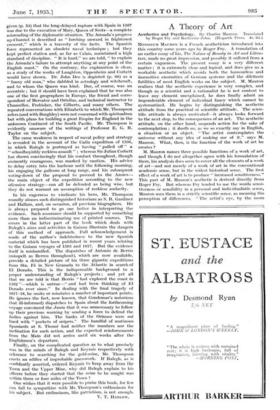A Theory of Art
MONSIEUR MAURON is a French aesthetician introduced into this country some years ago by Roger Fry. A translation of an earlier essay of his, The Nature of Beauty in Art and Litera- ture, made no great impression, and possibly it suffered from a certain vagueness. The present essay is a very different matter ; it is extremely clear and logical, and does give us a workable aesthetic which avoids both the humourless and insensitive enormities of German systems and the dilettante futilities of most English works on the subject. M. Mauron realizes that the aesthetic experience is very complex, and though as a scientist and a rationalist he is not content to leave any element unexplained, he does finally admit an imponderable element of individual fancy which cannot be systematized. He begins by distinguishing the aesthetic attitude from the practical or scientific attitude. The scien- tific attitude is always motivated—it always looks forward to the next step, to the consequences of an act. The aesthetic attitude, on the other hand, suspends action for the sake of contemplation ; it dwells on, as we so exactly say in English, a situation or an object. "The artist contemplates the universe without any idea of making use of it," says M. Mauron. What, then, is the function of the work of art he creates ?
M. Mauron names three possible functions of a work of art, and though I do not altogether agree with his formulation of them, his analysis does seem to cover all the elements of a work of art—and not merely of a work of art in the conventional academic sense, but in the widest historical sense. The first effect of a work of art is to produce "increased sensitiveness." This part of M. Mauron's aesthetic is derived directly from Roger Fry. But whereas Fry tended to use the words sensi- tiveness or sensibility in a personal and individualistic sense, Mauron uses them in a strictly scientific sense, as meaning the perception of differences. The artist's eye, by the more brilliant light of an attention concentrated on the present, sees more details, discerns finer shades. Difference, - and therefore originality, is accentuated." . • ' The second element in a work of art is the quality which produces "the multiplication of echoes." By this M. Mauron means the repercussions which 'a work of art excites in the complex network of our nerve tissues—our past impressions, feelings and desires. This action may be due not only to the direct pictorial or representational content of the work of art (it may not have any !), but more subtly to unconscious associations.
The third element is much more difficult to appreciate. The author calls it "the dissolution of the practical organiza- tion of reality, giving place to other possible organizations." It is what Roger Fry used to call a system of formal relations. From the point of view of the spectator, it is the perception of pattern or order in a work of art, but the aesthetician has to ask why such a perception should give rise to a feeling of pleasure. M. Mauron's answer to this question is, I believe, the right one. From his primary definition of the aesthetic order it follows that such order can have no practical purpose. The pleasure comes from the contemplation of order ; perhaps it comes at the moment of the perception of order, and the emotion is merely one of discovery (akin to the joy of solving a puzzle). The artist, from this point of view, is merely a skilful puzzle-maker ; his business is to avoid the obvious, to give our senses an exciting run. But he is not dealing, as a rule, with abstractions, but with shapes and resemblances which have analogies in reality (conscious or unconscious). That adds infinitely to the complication of the process, lifting it onto a spiritual level and distinguishing it from the puzzle and the mathematical problem. The end is nevertheless only pleasure, however intellectual ; the artist "has absolutely no interest in the practical efficiency of the analogies he discovers, the paths he opens, the systems he constructs. In that direction his liberty is absolute ; the most absurd voyages are allowed him ; hence the frequent disagreements between the artist and the man of common sense, who often does not even suspect in what fantastic worlds the artist is at home."
- This bleak outline giveino idea of the charm of M. Mauron's exposition. A science of aesthetics, like a science of economics, will perhaps never be possible owing to the irreducible personal element. But what clarity of thought and subtlety of per-. ception can do for the subject is shown in Una brilliant essay, which should be read by everyone who desires to tidy up a corner of the mind generally full, of cobwebs and confusion.
HERBERT READ.











































 Previous page
Previous page